Forest Restoration
The goal of the restoration project is to restore the mauri (life essence) of the forest.
We are doing this is by removing plant and animal pest species, increasing the number and species diversity of native flora and fauna within the Reserve and supporting Pūkaha’s captive breeding efforts.
The bottom line is that if we remove enough of the introduced pest species, our native species will thrive and take care of themselves (with a little help from us along the way).
The Unfenced Reserve
Hectares of Reserve
Hectares of Buffer Control
Traps (approx.)
Creating an Oasis
A huge amount of effort by so many people has been put into restoring the forest over the years.
The project was initially started by the Department of Conservation. They undertook the initial set up and management and then as the community got involved over time, stepped more into a support role. Pūkaha is a fantastic example of our national conservation organisation, iwi, local government and the community working together.
The Reserve itself is a mix of regenerating farmland and mature forest. Goats were completely removed by DOC in the 1990s and there are almost no other large browsing animals present. This enables us to place our main focus on introduced predator and pest weed species control.
We are now not just trying to ‘guard the castle’ but we are starting to look outwards, to where our predators are coming from and targeting them there. Aside from reducing the rate of reinvasion, this has the added benefit of helping to create safe passage and ‘stepping stones’ for our native wildlife as they start to expand outside of the Reserve.
Predator Control
Our restoration programme is in a constant state of reevaluation and analysis.
We work closely with our local Department of Conservation Office and also partner with Boffa Miskell for additional expert advice. We believe firmly in being flexible enough to enable us to capitalise on both innovative and traditional methods and technology.
We are moving away from the old regime of trap density and network, and towards a targeted response by focusing more on quality of trapping, travel routes and key high catch areas/zones.
We have huge support from our neighbouring landowners and our two Regional Councils, the latter who have partnered with our restoration project and are themselves carrying out a significant trapping effort in the buffer zone.
Reserve and buffer traps are checked, cleared and re-baited at least once a month and in key areas every two weeks during the peak/high catch season.
We constantly vary our trapping methods, trap types and baits in a coordinated regime designed to remove as many predators as possible.
Pūkaha Volunteers
Hub of Learning
Pūkaha is one of New Zealand’s longest running restoration projects and our vision is to continue to be a place of learning for others.
In recent years, the Predator-Free 2050 movement has seen a large number of similar projects spring up around the country. We applaud this.
Aside from creating an unfenced oasis, the Reserve is now also acting as a ‘seed source’ of wildlife for the surrounding area. One of Pūkaha’s biggest success stories is the kōkako, with our last census in 2016/17 showing 30 territorial pairs, as well as a number of non-territorial juveniles. Other susceptible species are also thriving inside the Reserve.
More and more people are coming to us to find out what we are doing and what worked, and using this knowledge to help them jump ahead with achieving their own restoration goals.
“What we already have at Pūkaha is very special. The bird song inside the Reserve at times is phenomenal, which shows that the work we have all done is making a real difference.”
Predator Control Specialist, Backblocks Environmental Management
Meet the Team
Pūkaha has engaged John Bissell from Backblocks Environmental Management to oversee and deliver our predator control.
John is a predator control specialist around threatened species protection where he is often called on to target one animal in a large landscape.
He uses a combination of modern technology and methods alongside old-world trapping skills, engaging the high-quality services of Supplejack Contracting Ltd to assist in the field work delivery.
John lives by a simple question, which is never “are we catching?” but always “are we catching enough to make a difference and can we catch more?”
We also work closely with Boffa Miskell and in particular Dr Helen Blackie. Helen’s technical oversight enables Pūkaha to stay at the forefront of forest restoration.
John Bissell
Predator Control Expert
Pest Species
We control a variety of pest species using a range of methods.
Mustelids:
Stoats, Weasels and Ferrets
Mustelids are one of the greatest New Zealand conservation challenges. They can travel large distances and have been tracked moving 70km in two weeks!
The most common mustelid in New Zealand is the stoat, which lives in all habitats throughout the country. Stoats are partly responsible for the decline of many of our larger bird species such as kea, kākā and kiwi; in areas where stoats are present but not controlled, approximately only 5% of kiwi chicks will survive to maturity.
Stoats hunt from the forest floor to the canopy and are remarkable predators. Male stoats mate with female newborns, who then store the sperm until food resources are high. It is for this reason that high stoat numbers often follow on from a beech mast (high seeding) occurrence and the resulting explosion in rodent numbers.
Weasels are smaller and less common than stoats – in fact, they are often mistaken for the same species. They are highly mobile and hunt similar prey and box well above their weight.
Ferrets are the largest mustelid in New Zealand and are commonly found near farmland. Although they primarily hunt rabbits, they also prey on frogs, birds and even eels.
Ferrets can be particularly devastating on ground-dwelling and nesting birds such as kiwi as they can easily kill the breeding adults in a population, whereas stoats can usually only take juveniles up to 1200 grams.
Cats
There has been a noticeable increase in feral cats in recent years, which is concerning as they are highly effective predators.
They can have large home ranges and have had a huge impact on shore and river birds as well as native skinks and bats.
Their capacity to travel long distances means that we have to think large scale to control them.
Hedgehogs
Hedgehogs have adapted into highly capable predators since their introduction to New Zealand, covering large tracts of ground in search of food.
Invertebrates, eggs, chicks and lizards feature highly on their lists of favourite foods. Hedgehogs can have a significant effect on smaller ground-nesting birds.
Rodents
Rodents are our most complex challenge because of the rugged nature of the terrain, their small home ranges and rapid breeding rates.
There are two species of rat at Pūkaha, the ship (black) rat and the Norway rat. The ship rat is primarily a forest dweller with the ability to climb trees, while the Norway rat is larger and slightly less mobile.
Ship rats are most common, hunting everywhere from underground to the tops of trees. While they do eat seeds and fruit (which our many podocarp and beech trees produce), they also eat invertebrates like wētā, land snails and lizards.
Rats have a devastating impact on smaller birds, nests and chicks. A female ship rat can produce 5-8 young per litter on average and about 11 young per year, who become sexually active at 3-4 months old.
The big issue with rats is that they are neophobic which means that they are very cautious of anything new in their environment. They also carefully test food before consuming it all as they do not have a regurgitation reflex.
Possums
Possums have been systematically removed from the Reserve over the years and where they once occurred in large numbers, they are now very much on the back foot.
The Pūkaha restoration team put out 300 chew cards throughout the reserve in early 2019 to check for possum abundance and these were left out for a month. Only one possum was noted on the edge of the Reserve which indicates that we are getting close to our target of being possum free.
The Regional Councils carry out possum control in the buffer to minimise reinvasion from outside.
Want to help?
The best way for people to help our forest is by protecting and preserving it for future generations to enjoy. Through Sponsoring a Hectare you can make a yearly contribution from as low as $50 that goes towards trapping and preservation work in an area of our forest that you select. This helps ensure our native taonga (treaures) can survive and thrive. Find out more about sponsoring a hectare right here.

